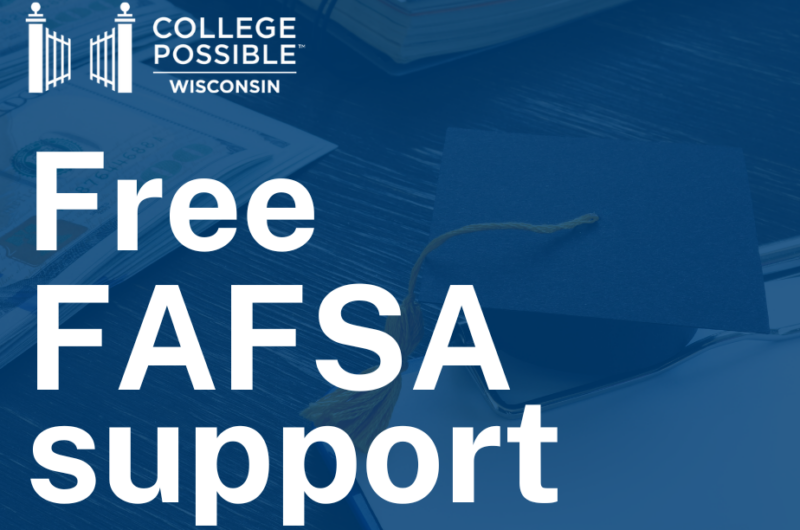Get the PDF – Understanding Financial Aid Award Letters
Financial aid award letters from school can be tricky to decipher, especially if you’re receiving them for the first time. We suggest contacting your College Possible coach to read through your award letter together. While financial aid award letter language can differ by school, here are some things to look for, as well as some tips and tricks to ensure you understand your award.
Overview
It’s important to keep in mind that you must submit a FAFSA or TASFA to be eligible for Federal and/or state financial aid. The priority deadline for applying for state financial aid in Texas is March 15th, 2024.
Financial aid award letters are how colleges and universities inform accepted students of the amount of gift and self-help aid they are being offered for that academic year. Often, financial aid award letters are not letters and can only be found in a digital format through your online portal. Many schools may not even send any notification that your award letter is available for viewing. It is crucial to check your student portals at least weekly throughout the remainder of your last semester of senior year. When schools send physical letters detailing the amount of financial aid offered, you will need to log in to your online portal to accept the aid.
The amount and type of aid a college can offer you is based on your Student Aid Index (SAI) generated by submitting a FAFSA or TASFA. Student Aid Index (SAI) is an index number that college financial aid staff use to determine how much financial aid you would receive if you were to attend their school. The information you report on your FAFSA or TASFA, including specific tax information and family income, is used to calculate your SAI.
The school’s Cost of Attendance minus the Student Aid Index (SAI) equals your financial need. Schools will not issue need-based financial aid awards (such as the Federal Pell Grant, Direct Subsidized Loans, and Federal Work-Study) that total an amount greater than your financial need. It is also important to keep in mind that schools don’t always offer financial aid that meets all of your financial need.
So what can you expect to see on a financial aid award letter? Whether receiving a physical letter or viewing aid awards via the school’s online portal, you can expect to see different types of financial aid. What is offered will depend on your SAI. Students with high SAI’s may only be offered loans, but many students are offered a combination of scholarships, grants, work-study, and loans. Students who submitted a TASFA will not be eligible for federal loans, federal grants, or Federal Work-Study, but are eligible for state grants and state work-study.
Types of financial aid
Loans: This is money that you will be expected to pay back with interest. Federal Direct Subsidized loans do not accrue interest while you are in school; unsubsidized loans do accrue interest rates while you are enrolled. Interest rates for these loans can be found at studentaid.gov.
Scholarships: This is money that you do not have to pay back. You can also apply for independent scholarships. The ones listed on your Financial Aid letter are being offered by your school.
Grants: This money also does not have to be paid back. This is given based on the amount of financial support the institution believes you need.
Work Study: This offers a potential part-time job at your university to help pay for school. This is paid as a paycheck to you.
Reading your financial aid letter
Students will generally begin to receive their financial aid packages in March. Still, students who submitted their FAFSA or TASFA later, especially those submitted after March 15th, may not receive aid packages until May or June.
There is no federal or state-mandated format for financial aid award packages, so each school’s award package will look different from the next. Some schools will include a breakdown of their Cost of Attendance, while others will simply list the various awards and their amounts. There is no uniform abbreviation for many loans and grants, so the same loan or grant offered by two different schools may be abbreviated differently by each school.
Some schools will offer institutional grants or scholarships that are only available to first-year students. These awards can be misleading in leading students to expect to receive that award each year they enroll at that college when, in reality, they will not be eligible to receive the award beyond their freshman year. This information may or may not be listed clearly in your financial aid award package, so you should make a point to call the financial aid office to inquire about any institutional grants or scholarships they are unfamiliar with.
Calculating the full price of college
It is important to look at two amounts to find out which school might be the best fit for you. The first thing to calculate will be Net Price of attending the school, or how much you will spend, including paying loans in the future, and Unmet Need, or how much money you will need to pay each year to attend.
Net Price for one academic year (excluding interest) can be calculated using the following formula:
Cost of Attendance (—) Scholarships (—) Grants = Net Price
Unmet Need can be calculated using the following formula:
Net Price (—) Loans = Unmet Need
Key Considerations
Identify your Financial Need
In order to identify your financial need, you will subtract your Student Aid Index (SAI) from the school’s Cost of Attendance (COA).
Identify the Net Price
In order to determine the net price, you must know the school’s cost of attendance and which of their financial aid awards are gift aid. Award letters help us determine what you will actually be paying over time, including loan repayment. Net Price is the Cost of Attendance (the sticker price) minus any gift aid (free money like grants and scholarships). What is left is the amount of money that you will pay each academic year – usually through federal or private loans, savings, work-study, or out-of-pocket.
Determine Unmet Financial Need
Next, determine your unmet financial need by subtracting all of your gift aid (grants and scholarships), loans, and work-study from your financial need.
Identify the Net Cost
The Net Cost is different from the Net Price because the Net Cost includes the amount of any loans (federal or private) that you accept. You get the Net Cost amount by adding your Student Aid Index (SAI) to the Unmet Financial Need. It is important to keep in mind that even though your Student Aid Index (SAI) is not included in the definition of unmet financial need, you will be accountable for paying that amount each academic year. The Net Cost is the cost of attending college that will need to be paid each academic year without support from federal or state financial aid.
Working While You’re a Student
For many students, working a part-time or even full-time job is necessary in order to make ends meet while enrolled in a postsecondary institution. Before you commit to working or counting on income from working, spend time thinking through what work and classes will look like in practice. Structure your schedule so you have time to study, as well as have a social life, and especially a strategy for self-care.
What is a Reasonable Amount of Debt?
College is an investment, and just like buying a house or a car, taking out loans is a normal part of that investment. According to the Houston Chronicle, the average Texas student borrows $27,000 in student loans, and 55% of Texas students graduate with student loan debt. However, unlike taking out a loan to buy a car, you can expect a better return on your investment in a college degree. In general, you should plan to graduate with less student loan debt than the salary you expect to earn in your first year after graduation. Over the course of a lifetime, and accounting for the cost of obtaining a degree, individuals with a bachelor’s degree earn about $400,000 more than individuals with a high school degree.
Costs of Housing
Living on campus will be a better bargain in some cities, but might be more expensive than renting in others. Explore the variability of housing costs on campus — oftentimes the school’s cost of attendance will take an average of the cost of all dorms. Take some time to explore the cost of rent for apartments and houses in the area, but keep in mind that you will need to factor in utilities, food, and commuting to campus.
Choosing a Program and a Career Path
When comparing schools and program costs, it is important to look not only at the postsecondary institution but also at potential costs and opportunities at individual programs. Review the required materials and any extra fees associated with your particular program on campus. Also, looking at the internship/study abroad/research opportunities inside a department, as well as its reputation inside the school, is very important. Sometimes, a university might have a great reputation for one area, but significantly less funding or opportunities in another.
Front-loading Financial Aid
A surprising number of colleges and universities will front-load their financial aid. This means that they offer more substantial financial aid packages to students during their freshman year than they offer the same student in subsequent years, even if nothing else changes on their FAFSA or TASFA. This most often takes the form of institutional gift aid (scholarships and grants provided by the college or university) that are provided only to freshman students. This will not always be clearly stated on a financial aid award letter, so take time to research any grants or scholarships that you are offered.
Transferring Schools
Most financial aid will not automatically transfer with you when you transfer schools. It is very important to work with both schools’ financial aid departments and send your FAFSA or TASFA to your new school. If you are receiving federal loans from your previous school, you will need to complete exit counseling for those loans.
Take time to explore how costs will look different at your new school. For example, if you transfer from a university with on-campus housing to a local community college, you may pay less in tuition but may need to pay more in transportation costs.
Talking with the Family about the Costs of College
Have a conversation with your support community (parents, guardians, relatives, etc.) about your financial plan for persisting through college. These can be difficult conversations, but they will be easier to have in advance rather than after a financial difficulty arises.
A few more suggestions
Accept all gift aid immediately
Accepting loans and gift aid in your school portal does not mean that you are committing to attending that school. If you don’t accept it, it could be offered to other students, so there is no risk in accepting it immediately.
Front loading
Some grants and scholarships are only offered during the first year of school, meaning the cost of attending could get more expensive as you progress. Look up each grant and scholarship to see if they are front loaded, or if will apply throughout your college journey.
Look at aid requirements
Some grants, work-study, and scholarships have GPA requirements, credit hour requirements, citizenship status, and satisfactory academic progress in order to maintain the aid. Be sure to educate yourself on all of these requirements.



